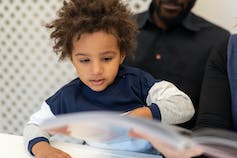7 everyday ways to foster children’s math and literacy skills to avoid ‘summer slide’ learning loss

Before going out, instead of doing the planning yourself, ask your child to help plan or map out the route, read a map, decide what to pack and check and prepare for the weather. (Pexels/RDNE Stock project)
The summer is a great time for children to play, relax and socialize with friends. It can also be a time when children lose some of what they learned during the school year.
Some psychologists and educators refer to the “summer slide” as the loss of learning that can happen over the summer months, when children are out of school. This loss in learning mostly affects math and literacy skills. Some studies suggest that children can lose up to a month of academic learning over the two months of the summer.
This learning loss is similar to what you would expect with any other skill that requires practice. Imagine, for example, that a violinist stops practising for two months. Their performance is likely to “slide” without constant practice, and the same applies to many academic skills, including math and reading.
The good news is that parents or caregivers can implement many different strategies to help prevent the summer slide. Many of these strategies are centered around free play, which is actually foundational for learning.
Importantly, preventing summer learning loss doesn’t need to involve formal teaching. We encourage parents and caregivers to find opportunities to augment play by making small additions that promote skills children have developed during the school year.
Strategies to enhance everyday learning
1. Integrate counting in daily activities. Although we sometimes don’t realize it, there’s math everywhere around us! When shopping at the grocery store, you can get children to gather a certain number of apples or bananas to encourage counting.

Opportunities to involve children in math are everywhere around us.
(Shutterstock)
When playing sports, you can integrate numbers, for example, by counting the number of passes with a soccer ball or baseball. When children are on the trampoline, parents can ask them to count their jumps out loud, or give them a multiplication (like three times four) and ask children to solve it and jump that many times.
Read more:
Homeschooling math lessons: Think dice games, cooking fractions and ratios with chocolate milk
2. Engage children in reflection, remembering and recounting activities to promote language skills. On a simple activity like a bike ride, for example, you could ask children to try to remember five things they saw on the bike ride and when you get home, have them describe them to you. Having children share stories and talking with adults helps support their language learning. Such details could also be included in a letter children write to family or friends as part of intentional and meaningful sharing.
3. Engage children in fun writing tasks.

Family members could share ideas about the kinds of details they recount in a journal.
(Shutterstock)
Ask children to journal about their day, or write letters and mail them to their friends, grandparents or cousins. Writing postcards can also be a fun way to engage in writing.
4. Involve children in activity planning to sharpen their thinking skills. If you go out for a walk or a hike, get your child to help plan or map out the route, read a map, decide what to pack and check and prepare for the weather. All these activities can help to sharpen children’s thinking and problem-solving skills.
5. Share stories and read books together in a variety of age-and developmentally appropriate ways. You can also try listening to audiobooks when your child has quiet time or when travelling to keep kids engaged in literacy and storytelling.

Sharing stories together fosters a love of stories and reading.
(Shutterstock)
If you have a family movie time, you could consider choosing children’s films based on books and first plan to read the book. You can discuss the similarities and differences between the two, what the child preferred from each, and so on.
6. Team up with neighbouring families and capitalize on each other’s strengths. For example, one day, one parent goes to the park for a play session. On a different day, a parent from another family co-ordinates a library visit at a time where there is scheduled shared reading time with the librarian. Libraries often organize free learning activities that can take some burden off of parents and caregivers.
7. Keep children’s minds moving by going to museums or local exhibits.
Some of these activities may take more time and may have a cost, but many museums have free weekly entry periods. Going to museums, the zoo or a science centre is a great way to engage in fun learning. When you are there, engage children’s critical thinking and observation skills by asking questions and participating in learning activities with them. Asking open-ended questions and engaging in meaningful conversations fosters children’s learning.
So, while it’s important for children’s well-being to ensure they play freely this summer, it’s also helpful to find time and space to insert some learning skills as part of play and nurturing relationships. Any activity that you and your child enjoy can be educational, sometimes with just small tweaks!
![]()
Audrey-Ann Deneault receives funding from the Social Sciences and Humanities Research Council and the Consortium national de formation en santé.
Sheri Madigan receives funding from the Social Sciences and Humanities Research Council, the Canadian Institutes of Health Research, the Alberta Children's Hospital Foundation, an anonymous donor, and the Canada Research Chairs program.
Marissa Nivison does not work for, consult, own shares in or receive funding from any company or organisation that would benefit from this article, and has disclosed no relevant affiliations beyond their academic appointment.






